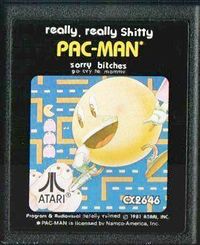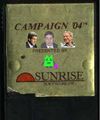User:Hrodulf/ColecoVision
User:Hrodulf/menu [[Image:Colecovision.jpg|thumb|300px|right|The ColecoVision]] The ColecoVision is Coleco's second generation video game console, released in August 1982. It offered arcade-like graphics and controllers, and an initial catalog of 12 titles, with 10 more promised titles on the way. All told, approximately 170 titles were released on plug-in cartridges during its lifetime. The controller was a flat joystick, two side buttons, and a number-pad, which allowed the user to put inserts for customized buttons. The majority of titles in its catalog were conversions from coin-operated arcade games. The ColecoVision introduced two new concepts to the home videogame industry - the ability to expand the hardware system, and the ability to play other video game system games.
Background[edit | edit source]
Coleco offered an add-on module that made it compatible with the industry-leading Atari 2600, giving it the largest software library of any console of its day. The module prompted legal action from Atari, but Atari was unable to stop sales of the module due to the fact that the Atari 2600 could be reproduced with off the shelf parts. Coleco was also able to make and sell the Gemini game system which was an exact clone of an Atari 2600 but with combined joystick/paddle controllers.
Expansion Module #2 came with steering wheel and pedal controllers, for use with the games Turbo and Destructor. Expansion Module #3, The third and final module, released in the summer of 1983, which was originally planned to be the "Super Game Module" (which would have used "game wafers" as the storage medium), expanded it into a full-fledged computer, the Coleco Adam. Coleco prototyped an expansion module to provide compatibility with the Mattel Intellivision, but never released it. There were also rumors that Expansion Module #3 was to have been a CED player for games such as Dragon's Lair and Space Ace.
By Christmas of 1982, Coleco had sold 500,000 units, mainly on the strength of its bundled games. While Atari's fortune had risen on the popularity of Space Invaders, ColecoVision was the first console to feature the hit Donkey Kong, by Nintendo. The ColecoVision's main competitor in the next-generation console space was the arguably more advanced but less commercially successful Atari 5200.
Sales quickly passed one million in early 1983, before the video game crash of 1983. The ColecoVision was discontinued in the spring of 1984. Even with its late difficulties, the ColecoVision still sold more than six million units. In 1986, Bit Corporation produced a Colecovision clone called the Dina, which was sold in the United States by Telegames as the Telegames Personal Arcade.
Today, Coleco emulators and games are widely available as abandonware on the Internet. Although the games remain copyrighted, the holders of ColecoVision games have tended not to enforce their copyrights, in contrast to Intellivision and some Atari games.
Games[edit | edit source]
Coleco's software approach was to go after licensed arcade games that Atari had missed and to make cartridges for the 2600 and Intellivision in addition to its own system. Realizing that Atari had firm support from Namco (creators of Pac-Man and many other hits), Coleco involved itself with companies like Sega, Konami, and Universal. The ColecoVision had enough power to produce near-arcade-quality ports, which boosted its popularity. Industry magazines like Electronic Games were unanimous in their enthusiasm over Coleco's machine.
Some of the more popular games included Donkey Kong (the pack-in), Donkey Kong Junior, Carnival, Ladybug, Mouse Trap, Smurf: Rescue in Gargamel's Castle, and Zaxxon. The ColecoVision didn't offer many revolutionary new games, since most of its popular titles were arcade ports. Still, it offered a few notable original titles like War Room, Illusions, and Fortune Builder, an early milestone in the style of SimCity. Most cartridges did not have an end-game to beat, but instead would loop around to the beginning, such as Cosmic Avenger.
Twelve second delay[edit | edit source]
All Coleco cartridges and most third-party titles had a twelve second delay before the game select screen showed up. A common, but incorrect, anecdote suggested that this delay was the result of a function in the ColecoVision that emulated the programming language PASCAL. The real reason behind the twelve second delay is a loop in the ColecoVision BIOS, so the delay was purely intentional. Some companies like Parker Brothers, Activision, and Micro Fun avoided the delay by simply bypassing the loop in the BIOS.
Other games[edit | edit source]
Coleco was infamous for not releasing the games it advertised. In most cases, it isn't certain if games that never came out were advertised using actual screenshots of a game or artist renditions designed to look like a completed game. Nevertheless, over fifty ColecoVision games were advertised in catalogs or on boxes, but never released.
In 1997, ColecoVision was given its first "homebrew" game, the Tetris clone Kevtris by Kevin Horton. Since then, designer of homebrew games John Dondzila has released three new ColecoVision games, Space Invasion, Star Fortress, and Purple Dino Demo.
Cartridge Designs[edit | edit source]
Screenshots[edit | edit source]
Image:Coleco_Donkey_Kong.png|''[[Donkey Kong (arcade game)|Donkey Kong]]''<br>[[Coleco]] ([[1982]]) Image:Coleco_Smurf_Rescue.png|''[[Smurf Rescue]]''<Br>[[Coleco]] ([[1982]]) Image:Coleco_Zaxxon.png|''[[Zaxxon]]''<Br>[[Coleco]] ([[1982]]) Image:Coleco_Galaxian.png|''[[Galaxian]]''<br>[[Atari]] ([[1983]]) Image:Coleco_Pitstop.png|''Pitstop''<br>[[Epyx]] ([[1983]]) Image:Coleco_Cabbage_Patch_Kids.png|''[[Cabbage Patch Kids]]''<Br>[[Coleco]] ([[1984]]) Image:Coleco_Congo_Bongo.png|''[[Congo Bongo]]''<br>[[Coleco]] ([[1984]]) Image:Coleco_Tournament_Tennis.png|''Tournament Tennis''<br>[[Imagic]]/[[Coleco]] ([[1984]])
Technical specifications[edit | edit source]
- CPU: Zilog Z80A @ 3.58 MHz
- Video processor: Texas Instruments TMS9928A
- 256x192 resolution
- 32 sprites
- 16 colors
- Sound: Texas Instruments SN76489A
- 3 tone generators
- 1 noise generator
- VRAM: 16KB
- RAM: 1KB
- Storage: Cartridge: 8/16/24/32KB
Similarities to other platforms[edit | edit source]
The ColecoVision contains the same CPU and graphics chip as the MSX1 and Sega SG-1000/SC-3000. It also shares a sound chip with the Sega machines, making them identical in hardware capabilities. The MSX contains a different sound chip that is very similar in capabilities, the General Instruments AY-3-8910. For this reason it proved very easy to port games between the three systems.
See also[edit | edit source]
{{Dedicated video game consoles}}
External links[edit | edit source]
- Category at ODP
- Article at The Dot Eaters, a complete history of the ColecoVision
- ClassicGaming's history of the ColecoVision.
- Complete Specs of ColecoVision An exhaustive specification guide and history of ColecoVision




